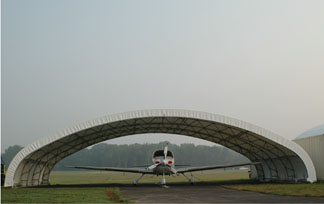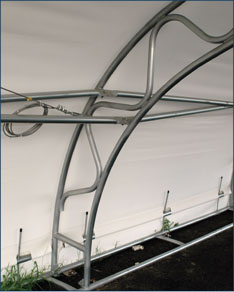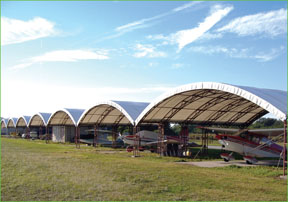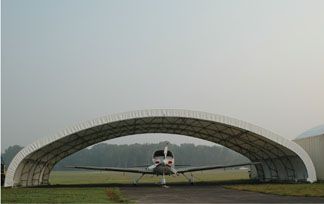
by Ben Barnard
What is it about hangars? Most airports have a years- long list of owners wanting them, acres of open land to build them and plenty of suppliers willing to do the work. Yet hangar construction seems to be a rarity. Airport boards drag their feet on permitting or simply reject the idea outright.
In desperation, this has caused some hangar-starved owners to consider so-called soft hangars-tent-like structures with fabric pulled over metal frames. Obviously, they should be cheaper because theyre quicker to erect than metal hangars and shouldnt require much site work or permitting, right?Not really.
Our investigation into soft hangars suggests that they arent necessarily cheaper than metal hangars, although they can do with less site preparation.Costwise, the most economical approach is a sunshade-style hangar open at both ends. These will provide surprisingly good protection for an aircraft, even in wintry climates in exchange for no options on heating or secure storage.
To gain some sense of soft hangar economics and practicalities, we interviewed both the manufacturers of these products and owners and airports who have installed them. Worth noting is that as in some segments of the metal hangar trade, these companies don’t build hangars as such, but shelters suitable for hangars. Most will custom build any size hangar the customer wants and they honor special requests of all kinds.
Shelter Structures
Shelter Structures, Inc. is based in Stuart, Florida and has been in business for about 20 years. Theyve sold hangars to private owners and FBOs throughout North America. If a structure requires a building permit, they can provide drawings signed by a structural engineer who is licensed in the contiguous 48 states.
Recently, the company won a contract to construct 36 sun shelters to cover training jets at air stations in Texas and Mississippi. These open-ended shelters are several thousand dollars cheaper than fully-enclosed hangars, a price point consistent with all of the manufacturers we spoke with.
Shelter Structures Bill Wolters told us that many owners shopping a fabric hangar against a steel one are disappointed initially from the misconception that fabric buildings are cheap. Rather, he explained, fabric hangars are just as durable and offer the same capabilities as their rigid counterparts but at a commensurate cost for an enclosed structure. Shelter Structures offers free estimates for hangars, on a project-specific basis, and Wolters said a fully enclosed hangar, with a zippered door, large enough to accommodate a light twin would cost between $11,000 and $15,000. An open-ended sun shade would cost about $10,000.
Shelter Structures has recently completed a product-wide redesign that includes heavier galvanized steel support trusses and stronger fabric, a 20- or 28-ounce PVC (polyvinyl chloride) industrial fabric with a thermoplastic fluoropolymer topcoat that resists UV exposure, is flame retardant and will slough off accumulated dust and dirt when it rains.
The material is slightly translucent so that no artificial lighting is needed during the day. The new fabric will last 20 years plus, while the old fabric was good for about 15 to 20 years. These structures are engineered to withstand winds of up to 90 MPH with the fabric on, 140 MPH with it removed.All structures are built to comply with local snow-load requirements.
Wolters said that smaller hangars can be assembled like an erector set by two people in an afternoon. Materials are delivered to the site and no special tools are required. The fabric is attached to the frame and tensioned with ratchets. Anchoring can be by auger stakes or the structure can be unanchored or even placed on wheels. Concrete floors or foundations, of course, raise the price considerably.
Fabric Structures-USA
Ken Stanley of Fabric Structures-USA told us his company has been manufacturing soft structures in Lake Worth, Florida since the 1970s. He likes to steer potential customers in the direction of a sunshade rather than a fully-enclosed hangar for several reasons. The first is price. He said that many people are put off by the $14,000 to $15,000 price tag for an enclosed hangar measuring 44 by 30 feet, the size of typical T-hangar. A sunshade of the same dimensions will cost under $10,000.
Second, in humid conditions, condensation forms on the inside of the fabric and unless you have a climate control system, you’ll have to vent it regularly to prevent the accumulation of moisture. His candor on this issue gave us pause. If you need air conditioning or even a fan to maintain a suitable storage environment, you’ll spend far more for a fabric structure than you would for a conventional sheet metal hangar. While ventilation may be cost-effective for industrial structures, its costs outweigh the benefits for a small hangar.

Fabric Structures-USA offers 18-, 24- and 28-ounce PVC fabric wrapped around hot-dipped galvanized steel trusses. The fabric is available in three opaque colors that will allow for natural lighting during the day. The 18-ounce fabric has an estimated life of 10 to 12 years while the heavier fabric will last for up to 20 years. Construction options are the same as those available with Shelter Structures and are generally accepted as the norm for soft structures: Save money if you do it yourself, spend more to have it done for you, including overall cost and any legal hoops you’ll have to jump through. For a free estimate, visit the companys Web site at www.fabricstructures-usa.com and plug in the size hangar youre interested in.
We visited a small, family-operated turf airstrip in rural Florida that had a row of 20 Fabric Structures-USA sunshades erected 20 years ago. These so-called pull-throughs are open sunshades anchored in concrete with adjacent units sharing support columns. (Newer versions don’t use the shared columns, however.) All of Fabric-USAs sunshades are free -standing so that they can be disassembled for repair or removal.
Concrete slabs were poured in the center of each unit to avoid mud bogs and tire ruts. Although the structures-which have been through at least two hurricanes recently-appeared to be in good shape, every shade had an accumulation of mildew, giving credence to Stanleys advice about moisture worries with enclosed hangars and even, apparently, open sunshades.
The owners told us other than a tiny twister bending some trusses, theyve had no maintenance problems with their sunshades. The fabric-affixed by tiedowns and tensioned with a system of cables-remained unscathed. Most of their customers are ultralight owners because the sunshades, at $125 a month, are cheaper to rent than sheet-metal Ts. That rental fee has more than covered their initial investment.
We asked about security issues. The owners conceded that there have been instances of gas cans and radios being stolen from the open structures, despite daily Sheriff patrols and a gate thats locked at night. But overall, the sunshades worked so we’ll that they commissioned 20 more from another soft shelter company, Big Top Manufacturing.
Big Top Manufacturing
Perry, Florida-based Big Top Manufacturing sells structures similar to the other companies, with translucent PVC fabric available between 18 and 28 ounces stretched over galvanized steel trusses. Big Top offers open-ended hangars for under $9000, with price increasing depending on size and options. The Big Top sunshades we saw in Florida were built to mirror those done by Fabric Structures-USA. The only difference between the two was that the trusses on the Fabric Structures were painted rather than galvanized.Both had mildew on the fabric.
John Eddowes, who operates a busy skydiving center in Cross Keys, New Jersey, erected two Big Top fabric hangars for maintenance bays and a private owner erected an open Big Top sunshade right next door. He told us it took about a day to erect each one and that the hangars were shipped with all the necessary parts and materials. He told us the instrutions provided with the hangars were clear and complete. Its so we’ll put together that erecting it is pretty easy. The hardest part is pulling the fabric over the frame, he told us.
Any cautions? They say no permit is necessary and thats right, technically, Eddowes said. But by code, if you anchor them, you do need a permit. Eddowes planned to leave his hangars in place for only a short period of time in Cross Keys, after which they would be moved to another airport in New Jersey. His advice is get the permitting squared away before buying the hangar. Eddowes hangars, each about 45 feet square and 19-feet high, cost $10,000, plus another $5000 for asphalt paving. Both are anchored with steel pins driven below the paving. Eddowes told us all three hangars have been through significant wind and snow storms with no physical damage, other than occasional retightening of tension cables.
As did Eddowes, G.W. Pridgon of Big Top stressed to us the issue of permitting, because portability is a selling point for soft hangars. Owners interested in soft hangars like that option, which is what sets them apart from fixed steel hangars that are comparable in price but usually have to be relinquished if an owner moves or the airport leasehold changes.
Speaking of which, public-use airports rarely sell land upon which to erect a hangar. The arrangement is usually a long-term leasehold with a monthly or yearly fee. These should be committed to a formal contract with a clear understanding that the fabric hangar you erect can be removed at your discretion.
Conclusion
Here are some numbers to ponder: Hangars are more commonly rented rather than bought. Typical monthly T-hangar rents range from $100 to $600, depending on geographical location. Using $250 (including leasehold) a month as an average, 10 years worth of T-hangarage will cost $30,000.
Although long-term rentals are the norm, hangar purchase deals arent unusual and T-hangars are usually built in project blocks at costs ranging from $10 to $25 per square foot, again, depending on the airport and the land arrangement. Pick the middle of that range and a typical 1000-square -foot T-hangar costs $15,000 to erect, with monthly leasehold fees on top of that.Our surveys reveal that some small hangars suitable for singles and light twins cost as much as $35,000. At the lower end of the scale, a $15,000 purchase to store a $100,000 airplane isn’t a bad option, in our view. If its available, that is.
An open-ended fabric shade hangar such as the Big Top model pictured on page 20 can be erected for about $10,000. Unlike a T-hangar, it can be built as a free-standing structure, if the airport will allow it. For those airports that will, a free-standing hangar may be the only short-term solution.

In 15 years time, a fabric hangar may need replacement fabric, costing about a quarter to half of the original cost. (If you don’t plan to keep it that long, this may not be a consideration.) Resale potential of soft hangars is an unknown but metal hangars at airports with long waiting lists are quickly snapped up when put on the market and most at least hold their purchase value, if not a higher resale value.
Bottom line: If you want a fully enclosed hangar, we think conventional metal construction is the better way to go, if you can make it work. Its competitive in cost and if built to the latest hurricane codes, more durable.Depending on local codes, fully enclosed fabric structures may require just as much site work-concrete footers and floors-as a metal hangar so savings for the equivalent protection are elusive. Metal hangars also have moisture issues, but far less so then enclosed fabric structures.
An open-ended fabric sunshade is appealing, in our view. It can be built for about a third less than a typical $15,000 metal hangar, requires minimal site work and you can save money by erecting it yourself. If its anchored, you’ll need permitting, but whether anchored or not, you can take it with you if you leave.
Further, at some airports, individual owners may be able to erect free-standing fabric sunshades on their own, where an individual metal hangar or a block of hangars wouldnt be an option. In our view, thats better than letting the airplane bake in the sun, hammered by rain and hail or buried in snow. And therein lies the allure of soft hangars.
Also With This Article
“Checklist”
“Robotic Hangars”
Contacts
Big Top Manufacturing, 800-277-8677, www.bigtopshelters.com
Shelter Structures, 800-330-9294, www.weatherblockshelters.com
Fabric Structures-USA, 800-424-5609, www.fabricstructures-usa.com
-Ben Barnard is Aviation Consumers assistant editor.


